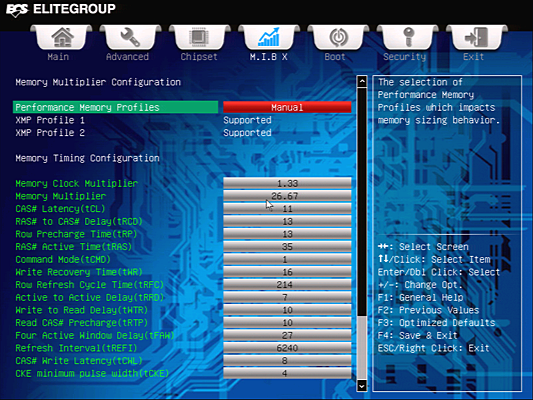Six $160-220 Z77 Motherboards, Benchmarked And Reviewed
Combining the newest features with moderate expandability, Intel’s mainstream platforms provide high value to most gaming and overclocking enthusiasts. We compare six examples with Z77 Express to find the best features, overclocking, and efficiency.
Z77H2-A2X Firmware
Though many of its earlier enthusiast-oriented efforts fell flat when it came to firmware, the Z77H2-A2X is a product in which ECS can finally take pride. A first in recent memory for ECS, setting CPU Voltage Mode to Ignore SVID allowed us to set the desired voltage, rather than guessing the results of an offset.
We had no problem pushing this review’s early-stepping Core i7-3770K to an ultra-competitive 4.69 GHz at 1.30 V, though the setting that got us that voltage was actually 1.25 V.
This is also the first ECS motherboard in our memory to provide Vdroop compensation, though over-compensation would be a more accurate term, since the lower Enabled setting kept us close to our desired limit.
ECS’ CPU Overclocking Configuration submenu includes base clock, CPU multiplier, and power limit controls.
Clicking through the Chipset Overclocking Configuration link brings up a slightly better titled memory menu. XMP is properly supported, though we had to switch to manual mode to reveal primary, secondary, and tertiary timings in this screen shot.
The motherboard does not have individual Auto settings for each timing, but perhaps goes one better by retaining previously-set values during the change. For these screen shots, we simply set XMP Profile 1 first, and those settings were retained as we switched to manual configuration.
The Z77H2-A2X got us a class-leading DDR3-2741 from a pair of G.Skill DDR3-2666 modules, but four-DIMM tests were far less exciting.
Get Tom's Hardware's best news and in-depth reviews, straight to your inbox.
-
yougotjaked There's a typo on the last page. It says X77H2-A2X instead of Z77H2-A2X :P It's on the second to last paragraph...Reply -
HMSvictory I am surprised that you guys did not include the Asus z77-VReply
http://www.newegg.com/Product/Product.aspx?Item=N82E16813131820 -
confish21 One thing i was looking for was the part about asrock not having true "digital" PWM and going with an analog PWM. Does this really matter?Reply -
Crashman TekN9NeGreat review! At the end of day, it comes down to brand loyalty.I don't think the article stated anything like that. It comes down to the features you want and the cards you plan to use. In the MSI vs ASRock debate, it's x8-x4-x4 with all three slots in PCIe 3.0 mode, or x8-x8-x4 with x4 in PCIe 2.0 mode, and you're definitely wiser to pick between them based on WHAT you plan to use in the third slot.simone saysdo you mean nvidia and intel gets news during weekends not only news but featured articles?It's Monday here, and editorial has very little contact with news.HMSvictoryI am surprised that you guys did not include the Asus z77-Vhttp://www.newegg.com/Product/Prod 6813131820Tom's Hardware didn't "include" anything in the review. A couple boards were excluded based on price, and everything else was let in. The P8Z77-V Pro was the cheapest board Asus sent.rickrentswhy not with Pci-e 3.0?Editor had no PCIe 3.0 cards. And the reason he didn't get one yet is because it didn't matter. The only thing that really mattered in a single-GPU MOTHERBOARD comparison was to use the same card on all platforms.confish21One thing i was looking for was the part about asrock not having true "digital" PWM and going with an analog PWM. Does this really matter?Some digital voltage regulators have been garbage, take a look at a few of the older reviews to see this. Very few have been very good. And many more analog voltage regulators have been garbage, while many more analog voltage regulators have been very good. Quality of execution is more important than the underlying technology.Reply




